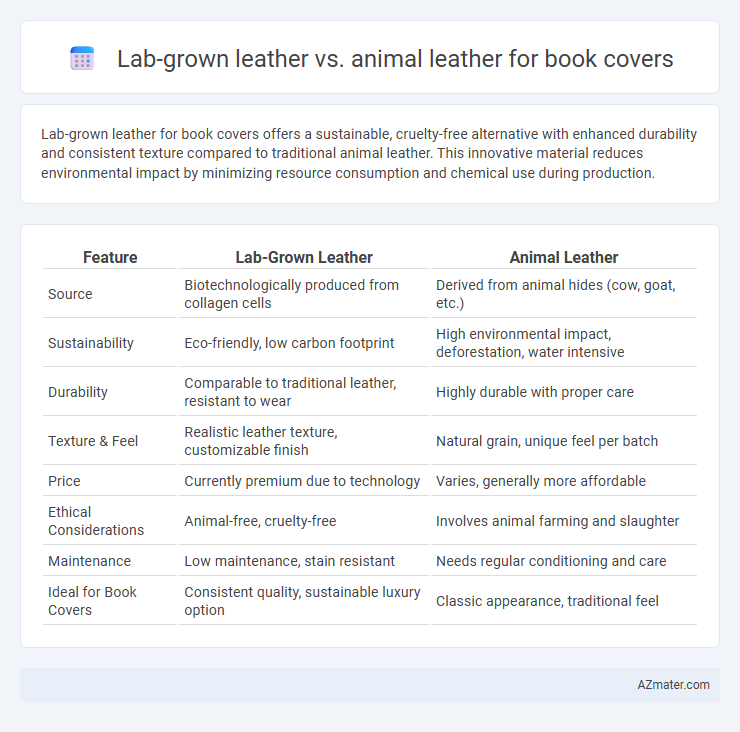Lab-grown leather for book covers offers a sustainable, cruelty-free alternative with enhanced durability and consistent texture compared to traditional animal leather. This innovative material reduces environmental impact by minimizing resource consumption and chemical use during production.
Table of Comparison
| Feature | Lab-Grown Leather | Animal Leather |
|---|---|---|
| Source | Biotechnologically produced from collagen cells | Derived from animal hides (cow, goat, etc.) |
| Sustainability | Eco-friendly, low carbon footprint | High environmental impact, deforestation, water intensive |
| Durability | Comparable to traditional leather, resistant to wear | Highly durable with proper care |
| Texture & Feel | Realistic leather texture, customizable finish | Natural grain, unique feel per batch |
| Price | Currently premium due to technology | Varies, generally more affordable |
| Ethical Considerations | Animal-free, cruelty-free | Involves animal farming and slaughter |
| Maintenance | Low maintenance, stain resistant | Needs regular conditioning and care |
| Ideal for Book Covers | Consistent quality, sustainable luxury option | Classic appearance, traditional feel |
Introduction to Lab-Grown and Animal Leather
Lab-grown leather is produced through cellular agriculture, creating a sustainable, cruelty-free alternative that mimics the texture and durability of traditional animal leather. Animal leather, derived from the hides of cows, pigs, and other animals, has long been valued for its strength, unique grain patterns, and natural aging properties. Both materials offer distinct benefits for book covers, with lab-grown leather gaining attention for its environmental advantages and animal leather maintaining its classic, artisanal appeal.
Production Process: Lab-Grown vs Animal Leather
Lab-grown leather is created through a biofabrication process that cultivates collagen cells in a controlled lab environment, minimizing resource consumption and environmental impact compared to traditional animal leather production. Animal leather production involves the raising and slaughtering of livestock, followed by tanning processes that use chemicals and large amounts of water, contributing to deforestation and pollution. This contrast in production methods highlights lab-grown leather as a more sustainable and ethically sourced option for book covers.
Environmental Impact of Leather Types
Lab-grown leather significantly reduces carbon emissions and water consumption compared to animal leather, which involves intensive livestock farming and deforestation. The production of lab-grown leather minimizes chemical waste and eliminates the need for toxic tanning processes, resulting in a lower ecological footprint. Choosing lab-grown leather for book covers supports sustainability by decreasing land use and reducing greenhouse gas emissions associated with traditional leather production.
Durability and Longevity Comparison
Lab-grown leather offers consistent durability and resistance to wear, making it a promising alternative for long-lasting book covers. Animal leather is renowned for its natural toughness and aging quality, often developing a unique patina that enhances its strength over time. While both materials provide excellent longevity, animal leather traditionally outperforms lab-grown leather in terms of durability under extreme conditions.
Texture and Aesthetic Differences
Lab-grown leather offers a consistent texture with fewer natural imperfections compared to animal leather, providing a smoother and more uniform surface ideal for book covers. Animal leather displays distinct grain patterns and natural variations that enhance its tactile richness and vintage aesthetic appeal. The choice between lab-grown and animal leather for book covers hinges on desired texture uniformity versus authentic character and visual depth.
Ethical Considerations in Leather Choices
Lab-grown leather offers a cruelty-free alternative to traditional animal leather, reducing harm to animals and minimizing ethical concerns related to animal rights. It also decreases the environmental impact by avoiding the extensive resource use and pollution associated with livestock farming and leather tanning. Choosing lab-grown leather for book covers aligns with sustainable and humane production values, appealing to ethically conscious consumers.
Cost Analysis for Book Covers
Lab-grown leather for book covers generally offers a cost advantage over traditional animal leather, primarily due to lower raw material and production expenses. Traditional animal leather involves higher costs related to livestock farming, tanning, and environmental compliance, which increase overall expenses for book cover manufacturing. Lab-grown leather's scalability and reduced resource consumption translate to more competitive pricing, making it an economically viable alternative for publishers and designers.
Customization and Design Flexibility
Lab-grown leather offers unparalleled customization and design flexibility for book covers, allowing precise control over texture, color, and thickness to suit specific artistic visions. This innovative material supports intricate embossing and printing techniques that traditional animal leather often cannot achieve due to its natural variability. Designers benefit from consistent quality and sustainable production methods, making lab-grown leather an ideal choice for tailored, eco-friendly book cover solutions.
Consumer Perception and Market Trends
Lab-grown leather for book covers is gaining traction due to its sustainable and cruelty-free attributes, appealing to environmentally conscious consumers seeking innovation in material sourcing. Traditional animal leather remains favored for its durability and luxurious texture, maintaining strong market demand despite ethical concerns. Market trends indicate a growing shift toward lab-grown alternatives driven by increasing awareness of environmental impact and advances in biotechnology improving material quality.
Conclusion: Choosing the Best Leather for Book Covers
Lab-grown leather offers a sustainable and cruelty-free alternative with consistent texture and durability, making it ideal for eco-conscious book collectors and publishers. Animal leather provides a traditional, luxurious feel with unique aging characteristics valued by artisans but involves ethical and environmental concerns. Selecting the best leather for book covers depends on balancing sustainability priorities with desired aesthetic qualities and long-term durability.

Infographic: Lab-grown leather vs Animal leather for Book cover
 azmater.com
azmater.com